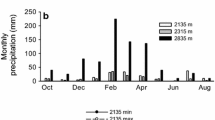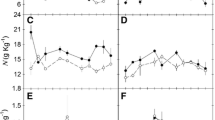Summary
This study examined the mode of photosynthesis (C3 or C4), daily and seasonal patterns of xylem water potential, seasonal patterns of field photosynthesis, and the laboratory gas exchange characterisitcs of plants which grow on or in the vicinity of Eureka Dunes, Inyo County, California. The perennial duneendemic Swallenia alexandrae was found to possess the C4 pathway while all other taxa surveyed were C3. Plants which grew on the dunes exhibited: 1) significantly less negative xylem water potentials, 2) dampened seasonal changes in predawn water potentials, and 3) smaller seasonal amplitudes of water potential than plants of the adjoining flats. The minimum water potentials experienced by Swallenia during the hot summer months were a third of those endured by adjacent non-dune Larrea. Non-endemics growing on the dune had more negative xylem water potentals than dune endemics, but still never approached the low values of non-dune plants. The poor moisture retention properties of sand may have selected for moisture-conserving traits (stomatal closure at relatively high water potentials, high water use efficiency) rather than moisture-expending ones (osmoregulation, high leaf conductances) in the endemic perennials. Field measurements of photosynthesis showed that dune-restricted (but not necessarily endemic) plants had high photosynthetic capacities and sustained summer carbon assimilation, the latter being protracted months beyond the last pulse of precipitation. The C3 annual Dicoria canescens ssp. clarkae maintained photosynthetic rates well exceeding those of the C4 Swallenia throughout the summer and may represent a previously undescribed physiological life form in desert plants. Laboratory measurements supplemented the field data and compared the water use efficiencies of two dune endemics. It is suggested that high photosynthetic productivity, high water use efficiency, and carbon allocation to the longitudinal growth of roots and shoots are important physiological adaptations to shifting sand and substrate moisture depletion at Eureka Dunes.
Similar content being viewed by others
References
Bagnold, R.A.: The physics of blown sand and desert dunes. New York: William Morrow and Co. 1941
Barbour, M.G., Cunningham, G., Oechel, W.C., Bamberg, S.A.: Growth and development, form and function. In: Creosote bush; Biology and chemistry of Larrea in new world deserts (T.J. Mabry, J.H. Hunziker, D.R. DiFeo, eds.), pp. 48–91. Pennsylvania: Dowden, Hutchinson and Ross, Inc. 1977
Beatley, J.C.: Phenological events and their environmental triggers in Mojave Desert ecosystems. Ecology 55, 856–863, (1974)
Brown, K.W., Jordan, W.R., Thomas, J.C.: Water stress induced alterations of the stomatal response to decreases in leaf water potential. Physiol. Plant. 37, 1–5 (1976)
DeDecker, M.: The Eureka Dunes. Fremontia 3, no. 4, 17–20 (1976)
De Jong, T.M.: Comparative gas exchange of four California beach taxa. Oecologia (Berl.) 34, 343–351 (1978)
Ehleringer, J.R., Björkman, O.: A comparison of photosynthetic characteristics of Encelia species possessing glabrous and pubescent leaves. Plant Physiol. 62, 185–190 (1978)
Ehleringer, J.R., Mooney, H.A., and Berry, J.A.: Photosynthesis and microclimate of Camissonia claviformis, a desert winter annual. Ecology 60, 280–286 (1979)
Evenari, M., Shanan, L., Tadmor, N.H.: The Negev; The challenge of a desert. Cambridge: Harvard University Press 1971
Frank, F.J.: Availability of ground water in the Clatsop Plains sand-dune area, Clatsop County, Oregon. U.S. Geological Surgey Open File Reports, Clatsop County Oregon (1968)
Hatch, M.D.: The C4 pathway of photosynthesis: mechanism and function. In: CO2 metabolism and plant productivity (R.H. Burris, C.C. Black, eds.), pp. 59–81. Baltimore: University Park 1976
Hsaio, T.C., Acevedo, E.: Plant responses to water deficits, wateruse efficiency, and drought resistance. Agric. Meteor. 14, 59–84 (1974)
Hsaio, T.C., Acevedo, E., Fereres, E., Henderson, D.W.: Stress metabolism: water stress, growth and osmotic adjustment. Phil. Trans. R. Soc. Lond. B. 273, 479–500 (1976)
Jarvis, P.G.: The estimation of resistances to carbon dioxide transfer. In: Plant photosynthetic production: manual of methods (Z. Sesták, J. Catský, P.G. Jarvis, eds.), pp. 566–631. The Hague: Junk 1971
Larcher, W.: Physiological plant ecology. New York: Springer 1975
McKee, E.D., Douglass, J.R., Rittenhouse, S.: Deformation of lee-side laminae in eolian dunes. Geol. Soc. of America Bull. 82, 359–378 (1971)
Mooney, H.A., Björkman, O., Collatz, G.J.: Photosynthetic acclimation to temperature and water stress in the desert shrub Larrea divericata. Carnegie Inst. Year Book 76, 328–335 (1977)
Munz, P.A.: A flora of southern California. Berkeley: University of California Press 1974
Noy-Meir, I.: Desert ecosystems: Environment and producers. Ann. Rev. Ecol. Syst. 4, 25–51 (1973)
Pavlik, B.M.: A synthetic approach to the plant ecology of desert sand dunes, Eureka Valley, California. M.S. thesis, Botany Department, University of California at Davis (1979)
Pearcy, R.W., Berry, J.A., Bartholomew, B.: Field photosynthetic performance and leaf temperature of Phragmites communis under summer conditions in Death Valley, California. Photosynthetica 8, 104–108 (1974)
Prill, R.C.: Movement of moisture in the unsaturated zone in a dune area, southwestern Kansas. U.S. Geol. Surv. Prof. Paper 600D (1968)
Scholander, P.F., Hammel, H.T., Bradstreet, E.D., Hemmingsen, E.A.: Sap pressure in vascular plants. Science 148, 339–346 (1965)
Sharp, R.P.: Kelso Dunes, Mojave Desert, California. Geol. Soc. of America Bull. 77, 1045–1074 (1966)
Shimshi, D.: A rapid field method of measuring photosynthesis with labelled carbon dioxide. J. Exp. Bot. 20, 381–401 (1969)
Shreve, F.: The desert vegetation of North America. Bot. Rev. 8, 195–246 (1942)
Smith, B.N., Epstein, S.: Two categories of 13C/12C ratios for higher plants. Plant Physiol. 47, 380–384 (1971)
Tiezen, L.L., Johnson, D.A., Caldwell, M.M.: A portable system for the measurement of photosynthesis using carbon-14 dioxide. Photosynthetica 8, 151–160 (1974)
Went, F.W., Westergaard, W.: Ecology of desert plants. III. Development of plants in the Death Valley National Monument, California. Ecology 30, 26–38 (1949)
Author information
Authors and Affiliations
Rights and permissions
About this article
Cite this article
Pavlik, B.M. Patterns of water potential and photosynthesis of desert sand dune plants, Eureka Valley, California. Oecologia 46, 147–154 (1980). https://doi.org/10.1007/BF00540119
Received:
Issue Date:
DOI: https://doi.org/10.1007/BF00540119




